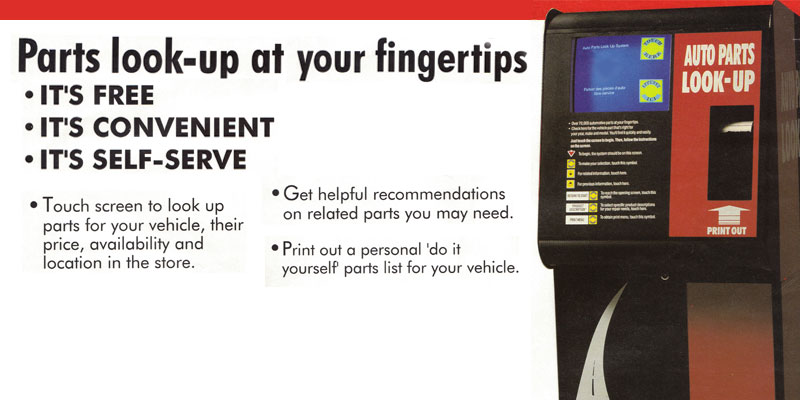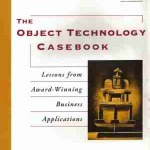
1993: Touchscreen Auto-Parts Lookup Kiosk
TOUCHSCREEN AUTO PARTS LOOK-UP SYSTEM
A major cost associated with the Do-it-Yourself sales of automotive parts is the need for supplying and maintaining paper based vehicle parts application catalogues. A major issue with these catalogues is that they are out of date the day that they are released. The time required to research and create the catalogue information as well as the time required to print, distribute and install them in the retail stores, contributes to the catalogues being out of step with the market by as many as 18 months. In addition, because the auto parts application catalogue are product specific (i.e. spark plugs, water pumps, etc…), they are not very good at identifying and recommending additional potential parts or service products (i.e. brake fluid, coolant, anti-rattle clips, etc…) required to effectively perform a vehicle repair.
The electronic auto parts catalogue used in the early 1990′s was designed for use mainly by experienced auto parts professionals. The data input methodology for the electronic catalogue was not deployed in a user friendly format as the necessary application information was entered and displayed as code (i.e. the vehicle year may be 1980, but the code entered would be a letter such as “H”, the vehicle manufacturer is a Ford but the input would be “FD”, etc…). As a result the traditional paper based application catalogues remained the best alternative at the time to meet the needs of the Do-it-Yourself market.
The continued improvements in hardware and software technology and the emergence of touchscreen technology provided the ideal environment to rethink the future need for paper based cataloguing for the Do-it-Yourself market. The initiative was not originally sanctioned by the organization as the information technology group at the time did not feel that it had the necessary programs and skills to undertake such a project. To pursue the validation that a Do-it-Yourself touchscreen auto parts look-up system could be successfully developed, implemented and easily understood by the users was initiated as a skunk works project. I organized and led a small team of internal parts database professionals along with external hardware and software configuration experts to scope the project. Within two weeks of the initiation, the project was successful in creating a working prototype using the existing auto parts look-up database support the professional user complex code driven interface. The program did not require a keyboard or mouse to navigate and the user could navigate the complex vehicle application data using common vehicle description terms such as 1989, Ford, Mustang, 2 Door, 5.0L engine using a touchscreen interface. Most importantly, the program not only provided the user with the part number and description that they were seeking, the list also included related parts and service products that may be necessary to complete the task professionally. A printout of this list was provided at the touch of the screen.
The prototype was demonstrated to the company’s senior management team and the information technology group as well as a select group of store operators. All participants were surprised at the outcome of the successful outcome of the project and immediately requested that further development be made to the program to ensure stability under day to day use. In addition, a dealer convention was planned within the next three months and that a roll-out version be made ready for this show. The team enthusiastically accepted the challenged and the program including several enclosures for the retail environment were made available and demonstrated at the dealer convention.
Shortly after the convention the project was given official corporate and dealer support and that the team develop a roll-out of the program. The mandate required that the launch occur within six months to a minimum 25% of the retail store locations. The coordinated effort of team successfully met the mandate of a successful roll-out of the innovative Touchscreen Auto-Parts Look-up System for the Do-it-Yourself marketplace.
The project was r ecognized in a broad range of automotive and retail industry publications for the innovative approach and use of technology to service the needs of retail customers. The most important recognition came from the Object Management Group (OMG) organization as it officially recognized and profiled the program and product in “The Object Technology Casebook – Lessons From Award-Winning Business Applications for 1994 and 1995″.
ecognized in a broad range of automotive and retail industry publications for the innovative approach and use of technology to service the needs of retail customers. The most important recognition came from the Object Management Group (OMG) organization as it officially recognized and profiled the program and product in “The Object Technology Casebook – Lessons From Award-Winning Business Applications for 1994 and 1995″.
The Toronto Star did a review of the Auto Parts Kiosk within a retail environment – SEE Toronto Star Review
